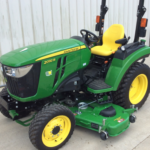 Tractor Agriculture will explain a topic called Tractor Chassis.
Tractor Agriculture will explain a topic called Tractor Chassis.
I used to accompany my father and enjoy the time on the fields, but alongside used to hear every tiny bit of knowledge that was imparted from him to the laborers.
I have heard a similar wording from my father and his workers in my teenage life. So, let me explain this jargon to you in a simplified manner.
What do we call a term which acts as a parent structure for many small items? This term was a sort of jargon term for me in starting but now this is an important defining area for my study.
Chassis is the base frame of a farm tractor on which all the components and assemblies like Engine, Transmission, Tires, Front Axle, Steering Systems and Electrical Systems are attached. So, the overall structure which binds all these components together in a tractor is called tractor chassis.
It is built very strong to bear the heavy lad and shocks received while working on the farms.
Functions of Tractor Chassis Frame
The various functions of tractor chassis are listed below:
• The load of assemblies like engine, transmission, steering etc is aptly supported by chassis frame design.
• The rear and front wheels are connected to each other using tractor chassis.
• The load of implements is also carried easily by this frame.
• The working on an uneven field normally causes more load production. This extra load is managed by the frame efficiently.
• The load incurred when tractor is working on the field along with an implement is also managed by this frame.
• The load produced by sudden application of brakes or acceleration is also managed.
• The cornering forces are nicely negotiated by these frames.
Types of Tractor Chassis Frames
These frames are divided into 2 types of categories. These divisions are listed below:
i) Chassisless Tractor
ii) Tractor having Chassis Frame
Chassisless Tractor
As the name implies, these tractors do not need any type of chassis frame. The normal of a tractor chassis frame is done by the Engine block itself. These machines are tough in nature to fulfill the requirements.
The front part of the engine block is fastened or attached to the front cross member while the engine block at rear side is attached to the transmission box. The front axle in front side is fixed.
The different brands of tractors use these types of frames. Massey Ferguson Tractors use perkin engine. Here, sump is made extra heavy duty and acts as a connecting link between front cross member and transmission links. It has been observed that tractors which use Automotive Engines have heavy duty sump which works as connecting link.
Tractor with Chassis Frame
The extra load is carried by the tractor chassis mechanics in this case. The engines in these vehicles are light in weight and cannot take extra load to act as chassis alternative. In this case, it is necessary to provide a chassis on which engine is mounted.
The chassis frame is connected to front cross member at front side and the rear side is attached to the transmission box.
The long members of these frames consist of following cross sections.
1) Tubular Section
2) Channel Section
3) Box Section
Tubular Section:
This type of section is mostly used in tractors where brackets are welded to the front and rear of tubular frame for the purpose of connecting.
Channel Section:
This is mostly used sections as it has more strength for a specific load. Here, 2 long members are fixed to the front end while the rear sides are attached to the clutch housing. This clutch housing is an important part of transmission box.
The major components are listed below:
• Gear Box interface
• Fixing the Bolts
• Clutch Housing
• Engine Mounting
• Chassis Long Members
• Front Cross Member
The Maintenance of Tractor Chassis
Tractor Chassis is made very strong to withstand the extra loads. So, these frames generally do not require much care during their life span apart from keeping the bolts tightened. In some cases, tractor might be used in extreme conditions and thus may cause some defects. These defects are specified below:
1. Loose Rivets
2. Cracks





